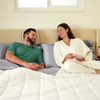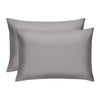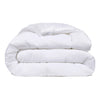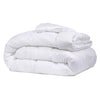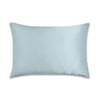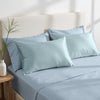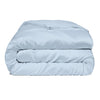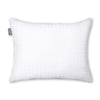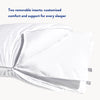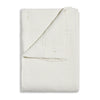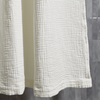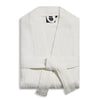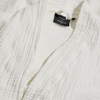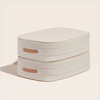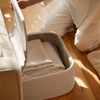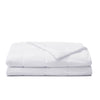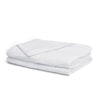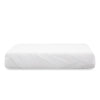The Daily Miracle
The Ultimate Guide to Bed Sheets: Types, Thread Counts, and More
Published
November 19, 2020
Author
Nicholas Crusie

That moment you pull back that fluffy, puffy duvet, and slide atop perfectly fitted, crisp, clean sheets doesn’t have to be reserved for your stay at a five star luxury hotel.
With so many options to choose from, navigating linens can be intimidating. But don’t settle for less than luxurious for bedtime - we’re here to help you select the sheets you’ve only ever dreamed about.
Let’s break down the bed sheet fundamentals.
Material
Different materials create different sleeping experiences, which is why selecting your sheets is personal.
Cotton
Cotton is the most sought after material for bed sheets because it is soft, breathable, durable, and affordable. Cotton has natural moisture-wicking properties, making it a great option for people who have night sweats. The life span of cotton sheets is approximately three times longer than any other material, and can withstand many washings and prolonged use without losing its shape.
But, not all cotton is created equal. The highest of cotton qualities include Supima Cotton and Egyption Cotton.
Supima Cotton
Grown in the US, this cotton is made unique by its extra-long staple fiber, making it superior when it comes to strength, softness, and color retention. Long and strong fibers keep it from getting stretched over time. Fiber length also indicates fabric softness, and these extra long fibers are to thank for its deluxe feel.
Egyptian Cotton
Egyptian Cotton is hand picked, which puts less stress on the fibers allowing it to be made longer to create very fine yarns without sacrificing the length. Therefore, creating stronger and softer cotton, as opposed to regular cotton, which has more splices. Egyptian cotton sheets are the most expensive of all cotton.
Use: year round
Care: wash warm, tumble dry, call it a day. Bleach safe.
Bamboo
![]()
Organic bamboo bedding is praised for its breathability. It is hypoallergenic, which means resistant to allergens, and antimicrobial, meaning they help slow and stop the spread of certain germs. We shed skin cells throughout the day and night, and dust mites live on these cells, collecting in soft, porous environments, like our bedding. This is a great option for people prone to severe, hypoallergenic allergies. But take into consideration that bamboo sheets are quite pricey and rather high maintenance.
Use: year round
Care: wash cold, separate, gentle cycle with mild detergent. Hang dry is preferred.
Flannel
Traditionally, flannel bedding was made out of carded wool or worsted yarn, but nowadays, you can find flannel made from wool, cotton, or synthetic fiber. It is valued for its softness, warmth, and affordability. Cotton flannel sheets are popular because while they are warm, they are also breathable, which means you shouldn’t get too hot. A few downfalls of flannel sheets include being limited to seasonal use, as well as being prone to “pilling,” which are balled up fibers on the fabric.
Use: cold, winter months
Care: upon first wash, add ½ cup of white vinegar to prevent pills and prevent colors from fading. Wash in warm or cold water and avoid fabric softener. Hang dry.
Linen
With just the thought of linen sheets comes along an image of airy, breezy fabric billowing in the wind on a clothesline of a country home. Although they sound quite dreamy, sleeping on linen sheets is pretty different from sleeping on other fabrics like cotton. Linen is more durable than cotton, and may feel a bit stiff at first, but it softens over time.
Linen is made from a natural fiber of the flax plant, deriving mainly from Europe. Linen sheets are known for their cooling benefits. They are considered “self-cooling” because the fibers in linen absorb perspiration and release it into the air. Linen is also a rather heavy textile, compared to cotton. So, this material may not suit you if you wouldn’t like extra weight on you while sleeping.
Use: Ideal for summer months, but can be used year round.
Care: cold water, mild detergent, hang dry preferred. Avoid fabric softeners. Store in a dry, well-ventilated area. If storing long-term, wrap in white cotton to last longer.
Silk and satin
Silk and satin are known to be luxurious, and make quite the status symbol. These bed sheets often come in a variety of colors giving you the ability to really expand on your bedroom aesthetic. Both will keep you warm during colder months and cool in warmer months.
Silk
![]()
Silk is made from fibers that develop from proteins secreted by silkworms. Silk is known for its softness, but because it is an animal product, it is time consuming to weave, giving it a very high ticket price. For durable silk sheets, look for a high thread count - 400 and above - plus a momme weight, which is the amount of silk used, between 12 and 19. If that number is lower than 12, the sheets are very thin and are more likely to tear.
Use: year round
Care: hand wash in cold water with a mild detergent, hang dry. Don’t wring out or hang in direct sunlight.
Satin
Satin sheets are traditionally woven from silk threads, with certain threads at the top. The top threads reflect light, giving it that high gloss finish satin is recognized for. Satin sheets are now offered in synthetic fibers like nylon, acetate, polyester, and rayon, which make them more affordable. Satin sheets should be woven and have a high thread count. If they cost much less, they likely weren’t woven, which means they will not be very soft and will lose their luster.
Use: year round
Care: if woven from silk, wash like silk. If woven synthetic, machine wash cold, delicate cycle. Dry on low.
Microfiber
Microfiber sheets are made of fabric composed of extremely fine fibers of polyester. They are affordable and very soft, as well as resistant to pilling. But polyester retains body heat, making it not very breathable. Although microfiber sheets have a very thin and light feeling, they manage to trap the air within it. Meaning: no good for the night-sweaters. It is is quite durable, like cotton, and holds dye well, so it won’t fade after multiple washes.
Use: colder, winter months
Care: machine wash warm or cold, tumble dry. Avoid fabric softener.
Maintenance
When sheet shopping, it is important to be honest with yourself about how much time you are willing to devote to keeping your sheets clean. Some sheets listed above need more TLC than simply tossing them in the wash with your gym attire. Can you truly see yourself hang drying to ensure your sheets maintain their integrity? Will you instead sacrifice cleanliness for longevity?
Most experts strongly recommend weekly washings. But, there are factors that could warrant washing more often. Some common mistakes people make when washing their sheets is tossing them in the machine with towels, or overcrowding their machine. Try to resist tossing your dirty towels in with your sheets, since towels produce lint which has a habit of sticking to bed sheets. To get the most out of the lifespan of your sheets, wash separately, in warm water, with a very gentle detergent.
Thread Count
Thread counts are a measurement of the number of horizontal and vertical threads per square inch. The yarn is woven in a crisscross pattern with the vertical strands called the “warp” weave, and the horizontal strands called the “weft” weave. Warp + weft = thread count.
Generally, the higher the thread count, the softer the sheet. But beware of astronomical thread counts - numbers over 1,000 - signal they are just for show. The problem is, companies use thread count as a marketing tactic of sorts. Intentionally inflating the number by adding unnecessary weaves, such as multiple yarns twisted together, in order to achieve that higher number. This doesn’t actually improve the fabric, and may even lower its quality.
A good rule of thumb is to look for sheets that have a range between 200 and 500. Anything less will feel rough, and anything higher is going to have a steeper cost and may have questionable quality.
Beauty Rest
If you’re into the antimicrobial qualities of Bamboo sheets, but don’t dig the price tag, Supima Cotton bed sheets are woven with anti-microbial silver that kills 99 percent of bacteria, meaning they stay cleaner, longer. This works because the ions in silver naturally carry a positive charge that draws in bacteria like a magnet and destroys them before they have a chance to reproduce.
Bedding that is antimicrobial also works against acne. It is great for people with eczema, easily irritated skin, sensitive skin, and acne-prone skin. Antimicrobial bedding prevents and reduces bacterial growth that would normally cause inflammation and irritation.
Silk and soft cotton sateen sheets are also great for hair health. Rough bedding can cause more hair breakage, especially if hair is often worn down while sleeping.
Mother Earth
If you’re worried about the impact of bed sheets on the environment, bamboo is a great option. Bamboo sheets have a smaller environmental impact, and produce a smaller carbon footprint. Since they utilize fast growing bamboo trees, an easily renewable source, they pose no substantial environmental impact.
![]()
Supima cotton is another eco-friendly option. Supima has a zero waste policy and every piece of the Supima cotton plant is utilized at harvest time. Even the seed itself is used to produce cottonseed oil, and after crushing the seed to extract the oil, the seed hull is a great source of protein that is integrated into feed mixes for livestock.
Terms to Know
- Brushed cotton – at the end of the manufacturing process, the cotton fabric is brushed on one side to remove excess lint and to raise the surface giving a soft and fluffy finish.
- Combed cotton – has been combed to remove the short fibers and leave the long ones, which makes for a strong, soft fabric.
- Damask – a rich, lustrous fabric made of silk, linen, cotton of wool, with reversible patterns woven into it.
- Jersey – a type of fabric construction that originated in the Channel Islands and which can be made of various materials, including cotton and synthetic fibers. It produces a lightweight and stretchy finish, ideal for draped textiles.
- Sateen– is a cotton cloth made with a satin weave, a weave that produces a very soft, lustrous feel but can be somewhat less durable than a tighter weave.
- Percale– is the crisp, durable plain weave fabric typically used for sheets; it has a thread count of at least 180.
- Ply – the particular number of threads from which a fabric is made.
Tips for Guaranteed Satisfaction
What if you took the plunge? You chose the sheets, washed them, put them on your bed, and cuddle up to find...they’re not what you were expecting?
- Make sure you choose a company that shows grace to their customers, perhaps with a trial period and money back guarantee.
- Pay attention to return and exchange policies.
- If you have a thick mattress pad, look for sheets with deep pockets, so they won’t slip off the sides.
- If you sleep with a partner, be sure to include them in the selection process.
- Read product reviews.
- Commit to a cleaning regimen.
Summary
In conclusion, selecting your bed sheets can definitely be a tricky process. Carefully select the material, thread count, and consider the effects your bedding of choice will have on your body and the environment. Get yourself the good night you deserve, and you’ll appreciate it every day.
 |
Did you know?To get the most out of the lifespan of your sheets, wash separately, in warm water, with a very gentle detergent. |

